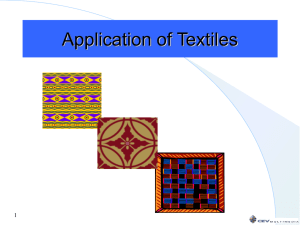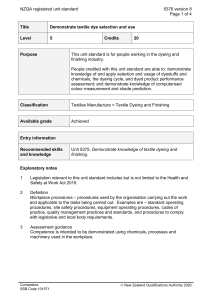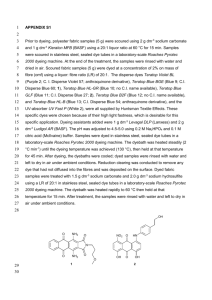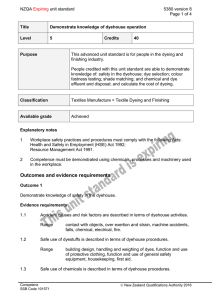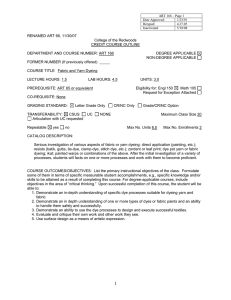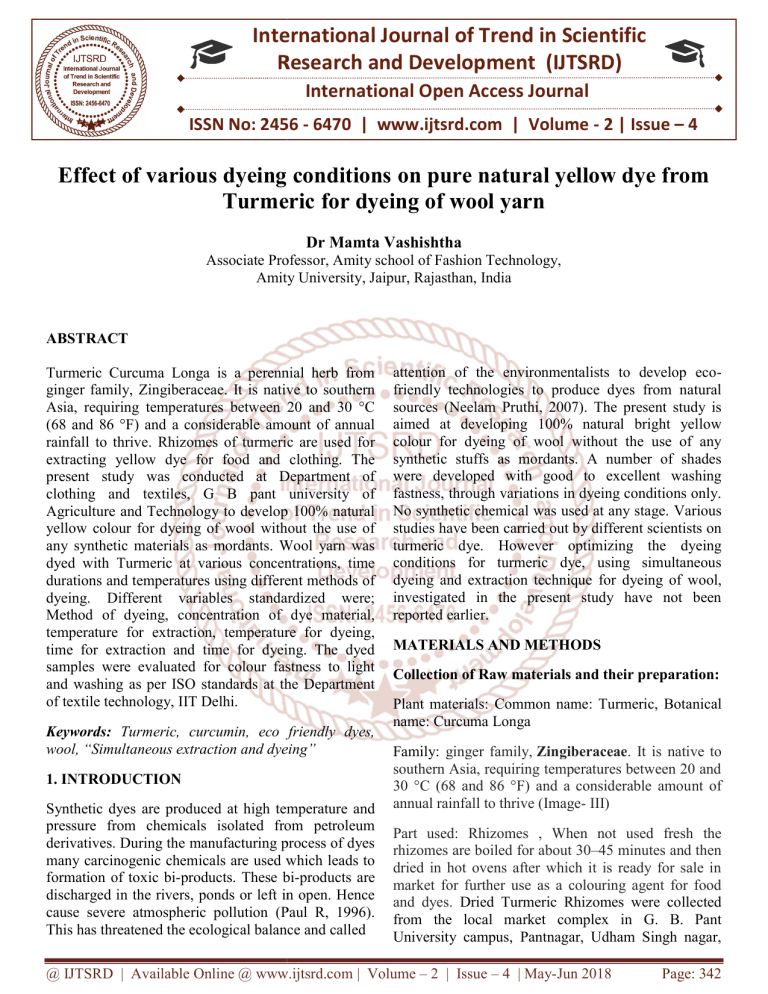
International Journal of Trend in Scientific
Research and Development (IJTSRD)
International Open Access Journal
ISSN No: 2456 - 6470 | www.ijtsrd.com | Volume - 2 | Issue – 4
Effect of various dyeing conditions on pure natural yellow dye from
Turmeric for dyeing of wool yarn
Dr Mamta Vashishtha
Associate Professor, Amit
Amity school of Fashion Technology,
Amity University
University, Jaipur, Rajasthan, India
ABSTRACT
Turmeric Curcuma Longa is a perennial herb from
ginger family, Zingiberaceae. It is native to southern
Asia, requiring temperatures between 20 and 30 °C
(68 and 86 °F) and a considerable amount of annual
rainfall to thrive. Rhizomes of turmeric are used fo
for
extracting yellow dye for food and clothing. The
present study was conducted at Department of
clothing and textiles, G B pant university of
Agriculture and Technology to develop 100% natural
yellow colour for dyeing of wool without the use of
any synthetic
ic materials as mordants. Wool yarn was
dyed with Turmeric at various concentrations, time
durations and temperatures using different methods of
dyeing. Different variables standardized were;
Method of dyeing, concentration of dye material,
temperature for extraction, temperature for dyeing,
time for extraction and time for dyeing. The dyed
samples were evaluated for colour fastness to light
and washing as per ISO standards at the Department
of textile technology, IIT Delhi.
Keywords: Turmeric, curcumin, eco friendly dyes,
wool,, “Simultaneous extraction and dyeing”
1. INTRODUCTION
Synthetic dyes are produced at high temperature and
pressure from chemicals isolated from petroleum
derivatives. During the manufacturing process of dyes
many carcinogenic chemicals are used which leads to
formation of toxic bi-products.
products. These bi
bi-products are
discharged in the rivers, ponds or left in open. Hence
cause severe atmospheric pollution (Paul R, 1996)
1996).
This has threatened the ecological balance and called
attention of the environmentalists to develop ecoeco
friendly technologies
hnologies to produce dyes from natural
sources (Neelam Pruthi, 2007).
2007) The present study is
aimed at developing 100% natural bright yellow
colour for dyeing of wool without the use of any
synthetic stuffs as mordants. A number of shades
were developed with good to excellent washing
fastness, through variations in dyeing conditions only.
No synthetic chemical was used at any stage. Various
studies have been carried out by different scientists on
turmeric dye. However optimizing the
t
dyeing
conditions for turmeric dye, using simultaneous
dyeing and extraction technique for dyeing of wool,
investigated in the present study have not been
reported earlier.
MATERIALS AND METHODS
Collection of Raw materials and their preparation:
Plant materials: Common name: Turmeric,
Turmeric Botanical
name: Curcuma Longa
Family: ginger family, Zingiberaceae.
Zingiberaceae It is native to
southern Asia, requiring temperatures between 20 and
30 °C (68 and 86 °F) and a considerable amount
amou of
annual rainfall to thrive (Image
Image- III)
Part used: Rhizomes , When not used fresh the
rhizomes are boiled for about 30–45
30
minutes and then
dried in hot ovens after which it is ready for sale in
market for further use as a colouring agent for food
and dyes. Dried Turmeric Rhizomes were collected
co
from the local market complex in G. B. Pant
University campus, Pantnagar, Udham Singh nagar,
@ IJTSRD | Available Online @ www.ijtsrd.com | Volume – 2 | Issue – 4 | May-Jun
Jun 2018
Page: 342
International Journal of Trend in Scientific Research and Development (IJTSRD) ISSN: 2456-6470
Uttarakhand. Rhizomes were dried in shade and
pulverized in a powder form (Image: II)
Instruments:
Wiley mill installed in the department of Post
Harvest Technology, College of Technology,
Pantnagar was used for pulverizing the Turmeric
Rhizomes.
Optical density of dye solutions was measured by
Spectrophotometer- G5866C installed in the
department of Chemistry, College of Basic
sciences and Humanities, Pantnagar.
Electronic balance was used for weighing the dye
materials and wool.
Water bath with thermostatic temperature control
was used for dyeing the wool samples in glass
beakers under controlled conditions (Image: VI).
Mercury Bulb Tungston fluorescent lamp (MBTF)
Light fastness Tester installed at the department of
Textile Technology, IIT Delhi was used to test the
colour fastness of dyed samples to light.
Atlas Launder’ometer installed in the department
of Textile Technology, IIT Delhi was used for
testing washing fastness of dyed samples (Image:
IV)
Wool:
White Australian Merino wool was purchased from
Shree Gandhi Ashram, Haldwani, Uttarakhand (Image
I).
Image II: Turmeric Rhizome and Powder
Image III: Inflorescence of
Curcuma_longa_(Turmeric)
Blue Wool standards:
Blue Wool standards were used (for fading along with
samples) for testing colour fastness to light (Image:
VII).
Gray Scale:
Colour fastness rating was done with Grey Scale
for evaluating changes in colour and staining as
per ISO recommendations (ISO 105-A02: 1993
and ISO 105-A-03) (Image: V).
Image IV: Launderometer
Image I: The Un-dyed wool sample
Image V: Gray Scale
@ IJTSRD | Available Online @ www.ijtsrd.com | Volume – 2 | Issue – 4 | May-Jun 2018
Page: 343
International Journal of Trend in Scientific Research and Development (IJTSRD) ISSN: 2456-6470
The final range of shades was tested for colour
fastness to light and washing at the Department of
Textile Technology, IIT Delhi.
Dyeing Techniques:
Technique I:
Image VI: The water Bath for Dyeing experiments
Processing of wool: The scouring of wool was done
according to procedure mentioned by Hover 1976. A
detergent solution of 1 ml of Genteel with 100 ml of
hot water was prepared. When it was cooled to luke
warm, skeins of wool were immersed. Theses skeins
were stirred with a wooden spoon for 30 minutes.
Later skiens were taken out, rinsed with lots of warm
water. This treatment was repeated for three to four
times, every time the detergent quantity was reduced.
The skiens were squeezed and rinsed with tap water,
till they were freed of the traces of detergent (care was
takennot to scrub wring or mingle the skeins as it
might cause hardening and matting of wool). Washed
skeins of wool were allowed to dry and finally
weighed for further experimentation.
Optimization of different variables:
A series of experiments were conducted in order to
standardize the different variables; such as dyeing
technique, concentration of the dye material , time for
extraction of dye, time for dyeing, temperature for
extraction and temperature for dyeing.
For dyeing of samples the MLR (material liquor ratio)
selected was 1:10. The Optical density (OD)values of
the dye solutions before and after dyeing were
recorded. A sample of one ml was taken from each
beaker and optical density was recorded by diluting it
20 times. The percent absorption was calculated by
the following formula:
% Absorption = OD before dyeing – OD after
dyeing / OD before dyeing X 100
Dyed samples were judged by a panel of 15 judges
visually on the criteria of luster, evenness of dye,
depth of shade and overall appearance. From the total
marks obtained the percentage ratings were
calculated. Each optimized variable was used in
further experiments where ever desired.
Turmeric powder was tied in muslin bags (2 inch X 2
inch) with a thread to hold it. Pre soaked and weighed
wool sample, and dye bag were put in a beaker
containing 100 ml water. Beaker was placed in a
boiling water bath (100⁰c). Simultaneous extraction
and dyeing was carried out in glass beakers for one
hour.
Samples were stirred and dye bags were pounded with
a glass rod after every five minutes to ensure even
dyeing and continuous extraction of dye from muslin
bag. After one hour dye bags were taken out and dyed
samples were allowed to cool in dye bath itself. Then
the samples were rinsed under running water and
dried in shade.
Technique II:
In this technique the conventional method of dyeing
has been used. The dye was extracted for one hour in
a boiling water bath (100⁰c). The solution was then
cooled and filtered. Pre soaked wool sample of 10 g
was added to this dye solution and dyeing was carried
out at 80⁰c for one hour. The samples were stirred
with glass rod after every 10 minutes in order to
obtain an even dyeing on sample. After one hour
beakers were taken out of water bath and samples
were allowed to cool in dye bath itself. Dyed samples
were then rinsed under tap water and dried in shade.
According to results obtained Technique I was
selected for Turmeric dye. For further experiments
Technique I was used.
Measuring the
Technique I
Optical
density
while
using
During further experiments while using technique I,
each experiment was carried out as a pair of two. In
each pair of two beakers, two dye bags with same
contents and water were placed but presoaked
weighed wool sample was added only to one beaker
and both beakers were placed in dye bath for
extraction and dyeing. This was done in order to
facilitate recording of the optical density before and
after dyeing. Thus for each experiment the number of
specimen dye solutions was doubled. For example For
@ IJTSRD | Available Online @ www.ijtsrd.com | Volume – 2 | Issue – 4 | May-Jun 2018
Page: 344
International Journal of Trend in Scientific Research and Development (IJTSRD) ISSN: 2456-6470
optimization
of
concentration
3
different
concentrations i.e. 1g, 2g, & 3g were tested. Two bags
for each quantity- total 6 dye bags were placed in
separate beakers to carry out the experiment.
Concentration of dye material:
For optimization of concentration of Turmeric dye, 3
different concentrations i.e. 1g, 2g, & 3g were tested,
Simultaneous extraction and dyeing was carried out
for one hour at 100⁰c. The remaining process was
repeated as explained earlier. Optical density was
measured for all six solutions and dyed samples were
evaluated by judges.
Time for simultaneous extraction & dyeing:
Simultaneous extraction and dyeing was carried out
with optimized concentration, for three different time
durations i.e. 60, 120, 180 minutes respectively at
100⁰c. Rest of the procedure was done as mentioned
earlier. Optical density was measured for all six
solutions and dyed samples were evaluated by judges.
Temperature
dyeing:
for
simultaneous
extraction
&
Simultaneous extraction and Dyeing was carried out
with optimum concentration of dye for optimized time
duration at four different temperatures i.e. 40⁰c, 60⁰c,
80⁰c, 100⁰c. Optical density was measured for all
eight solutions and dyed samples were evaluated by
judges.
Preparation of Final samples:
Final sample was prepared by dyeing the presoaked
weighed wool sample with Turmeric using all
optimized variables i.e. optimized dyeing technique,
optimized concentration of dye material, optimized
time for extraction and dyeing and optimized
temperature for extraction and dyeing. This sample
was prepared for final tests to colour fastness and
washing (Table- A)
As per the results of evaluation by judges the shades
out of 13 shades were selected. Finally 9 different
shades of yellow were included in the final range of
shades (table- A ). Further Tests of the final range of
shades, for colour fastness to light and washing were
done at the Department of Textile Technology, IIT
Delhi.
Colour fastness Tests of dyed samples:
Colour fastness to Light: The dyed wool yarns were
mounted on a 6 cm wide card board frame in asheet
form (of parallel lengths) of 3x6 cm size. Along with
these Blue wool standards were also mounted. A strip
of thick black chart paper was pinned up so as to
cover half portion of the specimen and standards.
Thus samples half exposed were put inside Fadometer
and faded as per ISO recommendations. The standards
and specimen were checked after every few hours till
a contrast between exposed and unexposed parts of
specimen was equivalent to grade 3 on the Grey scale.
The samples were compared with Blue wool
standards and rated (Image VII).
Colour fastness to washing:
Yarns of test samples were made into sheet form of
parallel length measuring 10x4 cm and placed
between two pieces of undyed fabrics of same size.
The fabric on one side was wool and on other side
was cotton. These three layers were sewn from all
sides to form a composite specimen (Image: VIII).
Soap solution prepared for testing washing fastness
had 5 ml of Genteel per liter. Each composite sample
was treated in the Launder’o meter for 45 minutes at a
temperature of 50 ± 2⁰c. The liquor: material ratio was
50:1.The
samples
were
removed
from
Launder’ometer, rinsed thoroughly under running tap
water, dried and ironed.
The samples were graded on the basis of change in
colour of the samples and also the staining of the
adjacent fabrics with the help of Grey scales.
Evaluation of the samples for fastness to light and
washing:
The rating of the samples for fastness to light and
washing was done as follows;
Rating for colour fastness to light6
very good
5
Good
4
Fairly Good
3
fair
2
Poor
1
Very Poor
@ IJTSRD | Available Online @ www.ijtsrd.com | Volume – 2 | Issue – 4 | May-Jun 2018
Page: 345
International Journal of Trend in Scientific Research and Development (IJTSRD) ISSN: 2456-6470
Rating for change in colour
5
Excellent
4
Good
3
Fair
2
Poor
1
Very Poor
Rating for staining
5
Negligible or no staining
4
Slightly stained
3
Noticeably stained
2
Considerably stained
1
Heavily stained
Image VIII: Specimen for Washing fastness Test (All
3 layers visible, specimen placed between cotton &
wool fabric)
RESULTS AND DISCUSSION:
Turmeric is one of the oldest natural colouring agents
used throughout the world from ancient times
(Gulrajani M L). The rhizomes of the perennial
turmeric are the source of colour. It is cultivated in
almost all the parts of India Curcumin is the prime
principal constituent of yellow dye, along with other
constituents like monodesmethoxycurcumin and
bidesmethoxycurcumin, which also contributes fewer
amounts of pigment and flavour (GULRAJANI M L).
Under experimental trials, different methodologies
were adopted for the extraction of colour and dyeing
of wool. Figures and tables I to IV show the results of
the experiments.
Image VII: Specimen showing contrast after light
fastness Test
@ IJTSRD | Available Online @ www.ijtsrd.com | Volume – 2 | Issue – 4 | May-Jun 2018
Page: 346
International Journal of Trend in Scientific Research and Development (IJTSRD) ISSN: 2456-6470
2456
70
60
50
40
30
20
10
0
O.D. before
dyeing
O.D. after
dyeing
Percent
absorption
Dyeing
Dyeing
technique I Technique
II
Percentage of
visual rating
Dyeing
O.D.
Techniqu before
e
dyeing
O.D.
after
dyeing
Dyeing
0.27
technique
I
0.2
Percent Percenta
absorptio ge
of
n
visual
rating
25.92
64.33
Dyeing
0.2
Techniqu
e II
0.15
25
44.83
Figure I & Table I: Percentage ratings of visual analysis and dye absorption percentage with different methods
of dyeing for Turmeric (wave length- 380 nm)
70
60
50
40
30
20
10
0
O.D. after
dyeing
Conc. Of O.D.
dye
before
(g/100ml dyeing
)
1
0.24
O.D.
Percent Percent
after
absorpti age of
dyeing on
visual
rating
0.18
25
44.33
Percent
absorption
2
0.26
0.19
26
67.33
Percentage of
visual rating
3
0.25
0.18
28
54.5
O.D. before
dyeing
Figure II & Table II : Percentage ratings of visual analysis and dye absorption percentage (at 380 nm) with
different concentrations of dye for Turmeric
80
70
O.D. before
dyeing
60
50
O.D. after
dyeing
40
30
Percent
absorption
20
10
0
60 min.
120
min.
180
min.
Percentage of
visual rating
Time for O.D.
simultane before
ous
dyeing
extraction
and
dyeing
(min.)
60 min. 0.16
O.D.
after
dyeing
Percent Percenta
absorptio ge
of
n
visual
rating
0.04
75
55.5
120 min. 0.13
0.09
30.76
55.3
180 min. 0.15
0.13
13.33
38.83
Figure III & Table III : Percentage ratings of visual analysis and dye absorption percentage (at 380 nm) at
different time durations for Turmeric dye
@ IJTSRD | Available Online @ www.ijtsrd.com | Volume – 2 | Issue – 4 | May-Jun
Jun 2018
Page: 347
International Journal of Trend in Scientific Research and Development (IJTSRD) ISSN: 2456-6470
2456
80
70
O.D. before
dyeing
60
O.D. after
dyeing
50
40
Percent
absorption
30
20
Percentage of
visual rating
10
0
Temperatu
re
for
simultaneo
us
extraction
and dyeing
40⁰c
O.D.
befor
e
dyein
g
O.D.
after
dyeing
Percent Percen
absorpti tage of
on
visual
rating
0.25
0.11
56
72
60⁰c
0.2
0.1
50
56.33
80⁰c
0.16
0.1
37.5
47.66
100⁰c
0.15
0.12
20
48.16
40⁰c 60⁰c 80⁰c 100⁰c
Figure IV & Table IV: Percentage ratings of visual analysis and dye absorption percentage (at 380 nm) at
different temperatures for Turmeric dye
Figure I & table I show the results of colourimetric analysis (at 380 nm) and visual analysis at various
parameters explained earlier. As per the results technique one was selected as appropriate for turmeric dye as
this produced much better hue as compared to dyeing techni
technique II. The water soluble yellow dye from turmeric
rhizomes (Curcumin) is very fugitive in nature (Sachan & kapoor 2007).
). The hue becomes dull with exposure
to time and temperature. The conventional aqueous extraction procedure involves a time gap between
extraction of dye and actual dyeing of the substrate. This exposure to time gap makes the dye dull and
unappealing. In “Simultaneous
ous extraction and dyeing” the dyeing of substrate is carried out in same water bath
along with extraction of dye from the raw material. This experiment was conducted to compare and analyze the
results two different procedures of dyeing, by means of colorimetric analysis and visually by trained subject
experts. Simultaneous extraction and dyeing method was found to yield best hues of yellow dye as decided by
colorimetric tests and visual analysis. The colours are brighter and appealing as the dye is absorbed by the
substrate as soon it is released in water bath.
Fig II & table II reveal the results of optimization of concentration of Turmeric dye. According to results 2gms
of Turmeric per 100 ml of water, for dyeing 10 gm of wool was found as optimum concentration. Anshu (1987)
has recommended that 2 gm of dye is required per gm of wool to obtain optimum colour from natural dye
Turmeric.
eric. This is a bit different from findings of the present study i.e. 2 gm of Turmeric dye is required to dye
10 gm of wool. This variation in findings may be due to natural variation in sources of dyes used and also wool
used. It’s a well known fact that properties of natural products vary too much because of variation in
environment and nourishment of the source used.
Results of colorimetric analysis and visual analysis (to optimize the time for dyeing) show that 60 min. dyeing
time is appropriate for Turmeric.
meric. Maximum dye absorption was found at 60 min. duration (Table III and Figure
III). Results show that dyeing beyond 60 min. makes the hue dull. The decrease in colour strength for 120
minutes of dyeing may be attributed to desorption of dye molecules aass a consequence of over dyeing (Nagia F
A & El- Mohamedi, 2007).. Cavendish (1978) has reported that extraction time of natural dyes varies from 20
to 120 minutes. The observations of the present study fall within this range.
Fig IV and table IV show that 40⁰cc temperature provides the best results for dyeing with Turmeric.
Temperature beyond
eyond that made the hue more Gre
Greyish. The Dye absorption was also found maximum at 40⁰c.
40
The
he results indicate that high temperature should be av
avoided
oided for dyeing with turmeric if a bright hue is required.
However Saima Umbreen et.al report that maximum colour strength is obtained at 90c
90 but dyeing is not
uniform. (Umbreen Saima, 2008).. This variation in findings may be due to natural variation in sources of dyes
used and also procedures used. Even slight variations in environment, water, soil etc may cause variation in
crops and products.
@ IJTSRD | Available Online @ www.ijtsrd.com | Volume – 2 | Issue – 4 | May-Jun
Jun 2018
Page: 348
International Journal of Trend in Scientific Research and Development (IJTSRD) ISSN: 2456-6470
Various shades of yellow ie. Pale Dijon, Flaxen, Dijon, Dandelion yellow, Straw Yellow, Lion Yellow, Corn
Silk, Ripe Hay, pale Flaxen were achieved through different dyeing procedures during optimization process.
The optimized parameters were Dyeing technique I, conc. of dye 2%, temperature 40⁰c, Dyeing time- 60 min.
Table B: Ratings for colour fastness to light and washing
SN
Sample
Pale Dijon
Flaxen
Dijon
Dandelion Yellow
Straw Yellow
Lion Yellow
Corn Silk
Ripe Hay
Pale Flaxen
Ratings
for Colour fastness to washing
Colour fastness Ratings
for Ratings
for Ratings
to light
colour change staining
on staining
cotton
wool
2- 3
4
3-4
4
3
5
4
4-5
2
4
3
4
3
4-5
3-4
4
3
3-4
5
3-4
2
3
2
4
2
4
3-4
4
3
5
4
4-5
2-3
4-5
4
4-5
Table B shows the results of color fastness tests to
Light and Washing. Most of the shades exhibited poor
to fair fastness to light. The samples were found to be
affected by light rapidly. The shades processed at high
temperature exhibited a bit better colour fastness to
light. For shades done at high temperature a grade of
3 (fair) was observed. Over all the range of light
fastness grades were between 2 to 3 (poor to fair).
Samples showed better grades for colour fastness to
washing (3- 5). Best grades were observed for Flaxen,
Ripe Hay and Pale flaxen (4- 5) good to excellent for
change in colour, good for staining on cotton (4) &
good to excellent for staining on wool. Lowest ratings
were observed for Lion Yellow. Rest of the shades got
a satisfactory rating of good to excellent (4-5) for
colour change and staining as well.
CONCLUSION:
Today the protection of environment has become a
challenge for the chemical industries world wide, All
over the world the environment restrictions are
becoming stricter. The need to realize the importance
and the technology of natural dye is more urgent. This
is then led to returning to traditional and more natural
way of life (patel BH). Results of numerous
experiments reveal that same dye produced different
shades under different dyeing conditions. Standard
recipes have been developed for each shade. A range
of Flaxen to Dijon, Hay, straw, Dandelion, corn silk
and Lion yellow were achieved (Table A).
for
on
Observations proved that less temperature and
reduced time of dyeing give better results in terms of
colour appeal. Whereas analysis of the shade cards
after a prolonged time gap shows that the high
temperature and prolonged dyeing time produced
shades with more durable dyeing. Thus any of the
dyeing technique can be used as per the requirement
of end product. These colours were used at Alps
industries ltd. Ghaziabad, UP for dyeing cotton for
their export orders. To improve the light fastness of
these dyes, dyeing was carried out at fiber stage.
Which improved the colour fastness to light up to
grade 4 (a considerable improvement for colour
fastness to light).
Experiments reveal that this dye can be used as a safe
eco friendly dye. Numerous shades ; Pale Dijon,
Flaxen, Dijon, Dandelion yellow, Straw Yellow, Lion
Yellow, Corn Silk, Ripe Hay, pale Flaxen have
exhibited good washing fastness and fair light
fastness. There is a lot of scope to use the Turmeric
dye for obtaining numerous colour shades .
ACKNOWLEDGEMENT
Author is thankful to following agencies for their
support extended during course of study;
Deparment of Clothing and Textiles, G B Pant
University of Agriculture and Technology, Pantnagar,
Uttarakhand
@ IJTSRD | Available Online @ www.ijtsrd.com | Volume – 2 | Issue – 4 | May-Jun 2018
Page: 349
International Journal of Trend in Scientific Research and Development (IJTSRD) ISSN: 2456-6470
Department of Chemistry, G B Pant University of
Agriculture and Technology, Pantnagar, Uttarakhand
Department of Post Harvest Tech., G B Pant
University of Agriculture and Technology, Pantnagar,
Uttarakhand
Department of Textile Technology, I.I.T., New Delhi
Alps Industries Ltd, Mohan Nagar, Ghaziabad, UP
BIBLIOGRAPHY
1) Abrahart E N, Dyes And Their Intermediates,
London, Oxford Kergamon, 1977.
13) Patel BH, A. B. (2006). improving the
environmental and economic aspects of cotton
dyeing using vegetable dyes. colourage , 6:49 58.
14) Paul R, J. M. (1996). Classification Extraction and
fastness properties. textile Dyer and printer 31 (6 ,
)16- 24.
15) Pradeep KM, Pratibha S, Kamal KG, Harish T,
Pradeep S (2012) Extraction of natural dye from
Dahelia using ultrasound. Indian Journal of Fiber
and Textile Research,12:83–86
2) Cavendish, M. 1978.Golden Hands encyclopedia
of crafts. London, Routledge and Kegan Paul,
247- 252
16) Sachan K, Pal M. & Kapoor V. P. (2005)
Development of Eco-friendly dyeing profiles
using natural dyes, 92nd Indian science congress
Part III, Nirma university, Ahmedabad, 3-7 Jan,
2005.
3) Clark, G.L. ed. 1973. Encyclopedia of
chemistry.3rd ed.Van Nostrand Reinold company,
358- 364
17) Shenai, V.A. 1997, Technology of Textile
Procesing,
Sevak
Publications,
Bombay,
Indiociaty of a
4) Comptons Pictured Encyclopedia, Chicago, F E,
Compton Andcompany, 1955.
18) Tsatsaroni, E.G. & Eleftheriadis, I.C. 1994. 'The
colour and fastness of Natural Saffron', Journal of
society of dyers and colourists, vol 110(10),
pp.313- 315.
5) Dictionary of Economic Products of india.
1972.compiled by George Watt, Delhi, Cosmo
Publications.Vol.2, 143-151.
6) Gulrajani M L, Gupta D. (1993). Natural Dyes
And Their Application To Textiles. New Delhi: I I
T Delhi.
7) Gulrajani M L, Gupta D. (1992). Some studies on
yellow natural dyes; Part I. Indian Textile Journal,
(Jan 1992)50- 56.
8) ISI Hand Book of Textile Testing, (1982) Indian
Standards institution, New Delhi, 538- 539, 571572.
9) Mohanty BC, Chandranouli KV, Nayak ND
(1984) Natural dyeing processes of india. Calico
Museum of textiles, Ahmedabad, p 298
10) Nagia, F.A, & El- Mohamedi, R.S.R. 2006, Dyes
and pigments, vol. 75(3), pp. 550- 555
11) Naz S, Bhatti IA (2011) Dyeing properties of
cotton fabric using un-irradiated and gamma
irradiated extracts of Eucalyptus camaldulensis
bark powder. Indian Journal of Fiber and Textile
Research, vol.36(2):132–146
12) Pruthi Neelam, Chawla G.D. and Yadav S. (2008).
Dyeing of Silk with Barberry bark. Natural
product Radiance, vol. 7(1) , 40- 44.
19) Umrao Singh and Others (1983). Dictionary of
Economic plants in India. Indian council of
Agricultural research, New delhi, 51- 52
20) Sachan K & Kapoor VP (April 2007)
Optimization of extraction and dyeing conditions
for traditional turmeric dye. Indian Journal of
Traditional Knowledge, Vol6 (2), 270 -278 539,
571- 572
21) The wealth of India, Raw materials.1948.New
Delhi, PID- CSIR. Vol.V. 298- 305.
22) Rama, 1990. Optimization of Wool dyeing
procedure using natural dyes extracted from
Balsam & Parijatka flowers, Thesis, M.Sc.
G.B.P.U.A.&T. Pantnagar, 76 P.
23) Umbreen S, Ali S, Hussain T & Nawaz R
(2008).Dyeing properties of natural dyes extracted
from Turmeric and their comparison with reactive
dyeing. Research Journal of Textile and Apparel
Vol 12 (4).
24) Environmental standards and Green labels for
Textiles,
website:
http://www.ecolabelindex.com/ecolabels/?st=cate
gory,textiles
@ IJTSRD | Available Online @ www.ijtsrd.com | Volume – 2 | Issue – 4 | May-Jun 2018
Page: 350

